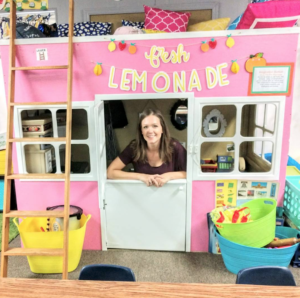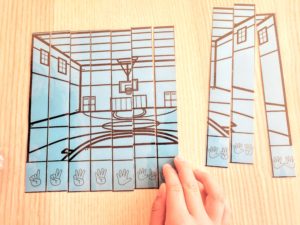We love sharing our favorite resources, books, classroom supplies and teacher stuff with you. When we do, we may earn money or products from the companies mentioned in this post. This does not affect our choices in what to recommend. Rest assured, we only recommend our favorite products to you! You can find our full advertising policy on the Partner With Elizabeth page.
Learning centers {also called stations} are an integral part of the learning process. They give the students an opportunity to put into practice what they have been learning. But the thought of introducing centers at the beginning of a new year can be very overwhelming.
Just imagine – it’s the first week of school and you are so excited to start the year with your new students. But then it hits you – they are all blank slates again. You are starting all over again.
Kindergarten, unlike other grades, has a twist of its own. Each year your students arrive as blank slates. They don’t know the rules and procedures of ‘school.’ So while other grades jump in to this thing called ‘school’ kindergarten teachers everywhere are laying the foundation.
That’s where it all starts – laying the foundation of classroom rules and procedures. I recently wrote a blog post about how I teach procedures during the first month of school. Once we have the basic classroom procedures in place I begin introducing centers.
Introducing Centers
Before introducing center time, I talk with my students about our new learning time called centers. We talk about what centers are and why they are important. I explain that I know they are old enough and ready to take some responsibility for their own learning. They LOVE knowing that they are growing up and that their teacher believes in them. Then I introduce the first center activity.
When we first begin center time I do not jump into a full center rotation all at once. In fact, we start with only one center. I usually start with a center that can be done at the table (just because they have already learned the procedures for working at the table). These number puzzles are the perfect example of a center I begin with.
With these number puzzles, I can provide a variety of different puzzles to the students, but the instructions for what to do remains the same. This allows me to explain the center to the entire class and even model what to do. However, each student at the table can have a different puzzle to work on.
Day 1 might look like this:
- Introduce center time
- Introduce first center activity
- Discuss expectations for center (work at table, work on floor, stay on task, etc.)
- Model the center activity while talking about what I am doing and reinforcing procedures and expectations
- Give each student a puzzle (already cut in a bag) and send them to practice.
- After about 3-5 minutes, I ring the doorbell to get the student’s attention
- We talk about putting away our supplies and then we do it
- We return to the carpet to talk about center rotation number 1
- Then we trade puzzles and do it all again
That’s it. Day 1 centers might be a total of 20-30 minutes and that includes the beginning discussion time.
Day 2
Assuming day 1 went pretty smoothly, on day 2 I will introduce a second center! If it didn’t go so well, then day 2 will be a practice day for the center that was introduced on day 1. Don’t rush it. If you gut tells you that your students need to practice again – then practice again. Remember the goal is to build good habits and procedures from the beginning! If you let them start poorly, it will be much harder down the road.
But if your class is ready to move on, then choose 1 more center to introduce. Again I choose a center that is simple to introduce with easy instructions. It might be something like playdough mats or magnetic letters.


The system for introducing this new center is the same as day 1:
- Introduce Center Activity
- Give clear procedures and expectations
- Model procedures and expectations
- Practice
Today during our practice we use both the number puzzles and the new center. I promise that everyone will get to do both centers so there is no reason to worry. Then we divide up and part of the class does number puzzles while the other part of the class does the new center. Today each center is a couple of minutes longer. At the end of time we practicing cleaning up our supplies. Then we switch!
Switching is actually very important. It helps the students learn from the very beginning that there is no need to be anxious about not getting to do an activity. Everyone will get a turn. This helps them to focus less on fear of being left out and more on the task at hand.
After the second rotation we might practice again or we might be done. It really depends on how they are doing and how their attention spans are doing. If you feel they need more practice, you can always split it up and do a couple rotations in the morning and a couple of rotations in the afternoon.
The Days Ahead . . .
For each of the days that follow, I continue to introduce one new center at a time. We do this until we have enough centers to start a full rotation. Remember – there is no rush in introducing centers and if this process takes a couple of weeks, or even a month, that is just fine!
As each new center activity is introduced, our steps remain the same.
- Introduce activity
- Give clear and simple procedures and expectations
- Model
- Practice
Along the way we will talk about our progress. We celebrate our victories like building up to a 10-12 minute center time. We encourage each other and talk about how we can improve. But most of all we build the foundation for independent learning.
My Favorite Centers
Choosing learning centers or stations is one of the things I really enjoy about my job. I love finding fun activities for my students that also help them learn. Sometimes I find ready made activities like these:
Other times I create a center to meet the needs of my students. Here’s a few resources I created that we love to use for centers.
There are Digital Math Centers and Digital ELA Centers available! Scroll down to the bottom of this post to try out these digital centers for FREE!
These task cards are available for Math and Language Arts too!
And sometimes, just sometimes, I come across something unique, zany or amazing that I just have to have for our classroom. Our pink house that we use for imaginary play is one of those things.

Keeping it all ORGANIZED!
Once we are ready to start our center rotations I put up a center board in the classroom. Here the students can find the centers they will go to, the order and the group of people they work with. This also helps me to schedule in small group teaching time.
Here’s a quick video all about how I organize our center time.
And you can find the Center Organization system I use in my Teachers Pay Teachers store.
Summing It All Up!
- Centers are an important part of our learning day
- Start small – introduce once center at a time
- Give clear procedures and expectations
- Model each center as your introduce it
- Practice, practice, and practice some more!
- Don’t reinvent the wheel – there are lots of ready made centers out there
- Keep center time organized with a center rotation system
And don’t forget my first month of kindergarten mantra – baby steps now for giant leaps later!
Give It a Try!
I’ve have added a couple of centers to the Members Only Free Resource Library so that you can get started right away! Join The Kinderhearted Classroom Community {it’s Free} to get your free center activities today! Look for these and other great center activities in the Free Resource Library!









